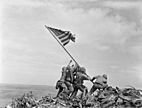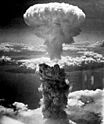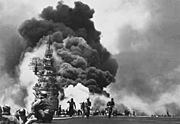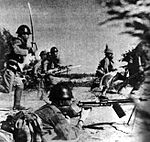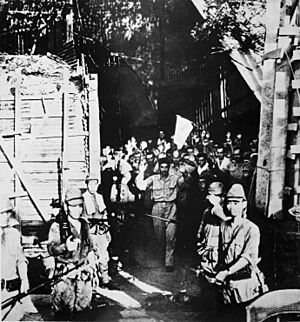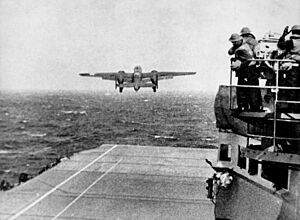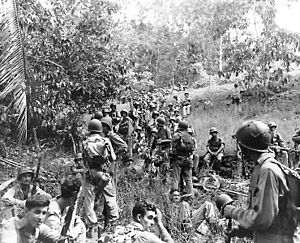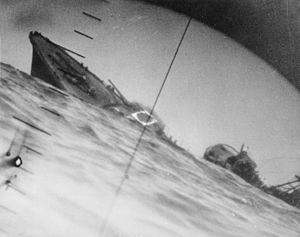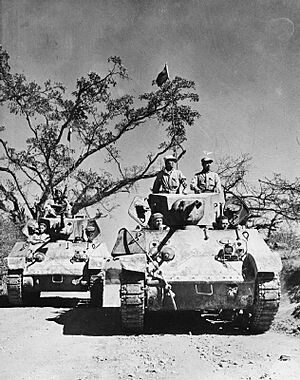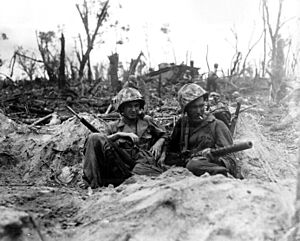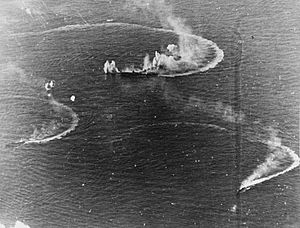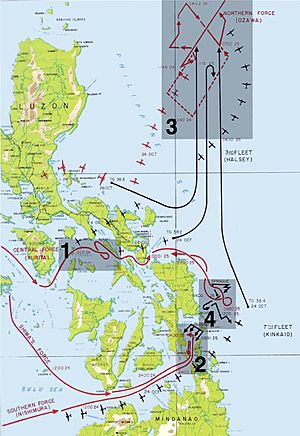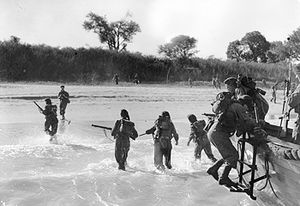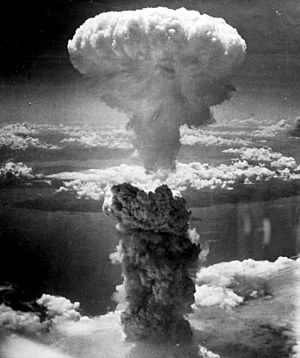Pacific War facts for kids
The Pacific War was a huge part of World War II. It was fought across a massive area, including East Asia, Southeast Asia, the Pacific Ocean, and the Indian Ocean. This war involved many countries and saw some of the biggest battles in history.
The war in the Pacific officially began on December 7, 1941 (December 8 in Japan). On this day, Japan launched surprise attacks on American military bases in Hawaii, Wake Island, Guam, and the Philippines. They also attacked British colonies like Malaya, Singapore, and Hong Kong, and invaded Thailand.
The main countries fighting against Japan (the Allies) were the United States, China, and the British Empire. Japan was helped by Thailand and, to a smaller extent, by Germany and Italy. Japan had early successes, but the Allies slowly pushed them back using a strategy called "island hopping." The Allies focused on defeating Germany first, but American factories kept producing more ships and planes. The war ended with massive air attacks on Japan and the atomic bombings of Hiroshima and Nagasaki.
Japan surrendered on August 15, 1945, and was then occupied by the Allies. Japan lost its colonies and its power was limited to its main islands.
Quick facts for kids Pacific War |
|||||||||
|---|---|---|---|---|---|---|---|---|---|
| Part of World War II | |||||||||
|
|||||||||
|
|||||||||
| Belligerents | |||||||||
Main Allies:
|
Main Axis: See section Participants for further details. | ||||||||
| Commanders and leaders | |||||||||
| Main Allied leaders | Main Axis leaders | ||||||||
| Strength | |||||||||
|
|||||||||
| Casualties and losses | |||||||||
|
|
||||||||
Contents
- What Was the Pacific War?
- Early Japanese Victories (1941–1942)
- Allies Fight Back (1942–1943)
- Fighting Continues in Asia (1942–1943)
- Allies Push Forward (1943–1944)
- Japan's Last Offensives in Asia (1944)
- The End of the War in the Pacific (1944–1945)
- Final Stages of the War
- Casualties of the War
- Images for kids
What Was the Pacific War?
The Pacific War was the part of World War II fought in Asia and the Pacific. It was the largest area of fighting in the entire war. This included battles in the Pacific Ocean, Southeast Asia, and the ongoing war between China and Japan.
Who Fought in the War?
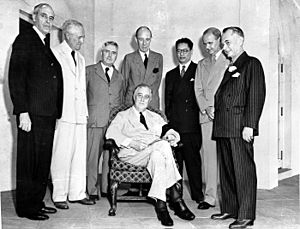
The main Allied countries were China, the United States, and the British Empire. China had been fighting Japan since 1937. The U.S. and its territories, like the Philippines, joined after Japan attacked them.
The British Empire included troops from the United Kingdom, India, Burma, Malaya, Australia, New Zealand, and Canada. The Dutch government, which controlled the Dutch East Indies, also joined the Allies.
The Soviet Union fought Japan in 1938 and 1939. They stayed neutral until August 1945, when they joined the Allies and invaded Japanese-held areas like Manchukuo and Korea.
Japan was the main Axis power in this war. They were helped by Thailand and by puppet states like Manchukuo and the Wang Jingwei regime in China. Germany and Italy had limited involvement, mainly with submarines and raiding ships in the Indian and Pacific Oceans.
Why Did the War Start?
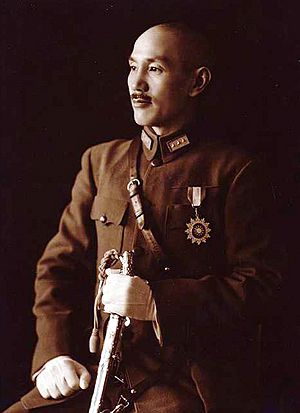
Japan had been expanding its empire for years. In 1931, Japan invaded Manchuria in China, looking for raw materials for its factories. By 1937, Japan wanted to control more of China. A small incident on July 7, 1937, led to a full-scale war between China and Japan.
The Chinese Nationalists and Communists, who had been fighting each other, decided to team up against Japan. The Soviet Union also sent aid to China. Japan captured major cities like Shanghai and Nanjing, where terrible events like the Nanjing Massacre occurred.
The United States and other Western countries did not like Japan's actions. They tried to stop Japan by refusing to sell them oil, iron, and steel. Japan needed these resources for its economy and military. Japanese leaders saw these actions as aggressive. They called these restrictions the "ABCD line" (American-British-Chinese-Dutch).
Japan's military leaders believed they needed to seize resources in the Dutch East Indies and Malaya. They also decided to attack the Philippines, Wake, and Guam, believing the U.S. would get involved anyway. Japan planned a quick war to capture key areas, set up defenses, and then negotiate for peace. They thought the U.S. and UK would be too busy with Germany to fight effectively.
Early Japanese Victories (1941–1942)
On December 7, 1941, Japan launched surprise attacks on the U.S. and British territories. These attacks happened in Hawaii, the Philippines, Guam, Wake Island, Malaya, Singapore, and Hong Kong. Japanese forces also invaded southern Thailand.
Attack on Pearl Harbor
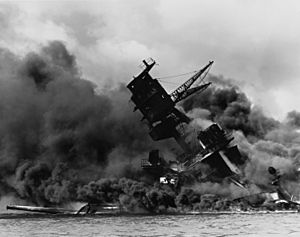
Early on December 7, Japan launched a surprise air attack on Pearl Harbor in Hawaii. They damaged or destroyed many American battleships and aircraft. Japan hoped this big blow would make the U.S. agree to peace.
However, the U.S. aircraft carriers were not at Pearl Harbor, and important naval facilities were not destroyed. The attack made Americans very angry, and the U.S. declared war on Japan the next day. The United Kingdom, Canada, and the Netherlands also declared war.
Japanese Advances in Southeast Asia

Thailand surrendered quickly after the Japanese invasion and allied with Japan. Japan also captured Hong Kong on December 25, 1941. British, Australian, and Dutch forces, already fighting Germany, could not offer much resistance. Two large British warships, HMS Repulse and HMS Prince of Wales, were sunk by Japanese air attacks off Malaya.
In January 1942, Japan invaded British Burma, the Dutch East Indies, New Guinea, and the Solomon Islands. They also captured Manila and Kuala Lumpur. On February 15, 1942, British forces surrendered Singapore to Japan. About 130,000 Allied soldiers became prisoners of war.
Japanese aircraft also attacked northern Australia, starting with the bombing of Darwin on February 19. In the Battle of the Java Sea, the Japanese navy defeated the main Allied naval force. This led to the surrender of Allied forces in Java and Sumatra.
In Burma, the Japanese pushed British and Indian troops back. They captured Rangoon and cut the Burma Road, which was a key supply line for the Chinese. Many Chinese troops had to retreat to India.
The Philippines Fall
On December 8, 1941, Japanese bombers attacked American airfields in the Philippines, destroying many planes. Most U.S. ships left for Australia, leaving ground troops, a few planes, and submarines to defend the islands.
Japanese troops landed on Luzon in late December. General Douglas MacArthur planned a final stand on the Bataan Peninsula and Corregidor Island. Japanese forces entered Manila without a fight on January 2, 1942. The Japanese attacked Bataan on January 7. After fierce fighting, Bataan fell on April 9. The 76,000 American and Filipino prisoners of war were forced to march long distances in the Bataan Death March.
MacArthur left for Australia, and General Jonathan Wainwright took command. Corregidor fell in May, and all remaining American-Filipino forces surrendered.
Australia Under Threat
Most of Australia's best troops were fighting in Europe. Australia was not ready for a Japanese attack. Prime Minister John Curtin asked for American help, saying Australia looked to America for leadership in the Pacific.
The Japanese captured Rabaul in New Guinea on January 23, 1942, making it a major base. Darwin, Australia, was bombed on February 19, the first attack on the Australian mainland. Over the next 19 months, Australia was attacked by air almost 100 times.
Some Japanese leaders wanted to invade Australia, but the army disagreed. Instead, they decided to isolate Australia by blocking sea routes. They planned to invade Port Moresby in New Guinea. President Franklin Roosevelt put MacArthur in charge of Allied forces in the Southwest Pacific. MacArthur moved his headquarters to Melbourne, Australia.
Allies Fight Back (1942–1943)
In early 1942, the Allies formed the Pacific War Council in Washington D.C. It included leaders from the U.S., Britain, China, Australia, and other nations. This council helped coordinate the war effort.
Doolittle Raid and Midway
In April 1942, the Doolittle Raid saw 16 American bombers take off from the aircraft carrier USS Hornet and bomb Japan. This raid caused little damage but boosted American morale and showed Japan that its homeland was vulnerable.
Japanese Admiral Isoroku Yamamoto planned to destroy the U.S. Navy by capturing Midway Atoll. He believed the U.S. would fight hard for Midway, allowing him to trap and destroy their fleet.
However, U.S. codebreakers discovered Japan's plan. The battle began on June 3. On June 4, Japanese planes attacked Midway, but American carrier aircraft were already on their way to attack the Japanese fleet. American dive bombers surprised three Japanese carriers, sinking them. The last Japanese carrier, Hiryū, launched a counterattack and damaged Yorktown. Later, American planes found and sank Hiryū. The damaged Yorktown was later sunk by a Japanese submarine.
The Battle of Midway was a huge defeat for Japan. They lost four aircraft carriers and many skilled pilots. This battle was a turning point in the Pacific War, stopping Japan's expansion.
New Guinea and the Solomons
Japanese ground forces continued to advance in the Solomon Islands and New Guinea. In July 1942, Australian troops fought a tough battle against the Japanese along the Kokoda Track in New Guinea. In September, Japanese marines attacked Milne Bay, but Allied forces pushed them back. This was the first land defeat for Japanese forces in the war.
On August 7, 1942, 16,000 U.S. Marines landed on Guadalcanal in the Solomons. The Japanese quickly responded, sinking four Allied heavy cruisers in the Battle of Savo Island.
For the next six months, both sides fought a brutal battle for Guadalcanal. American air power controlled the skies during the day, while the Japanese navy had an advantage at night. Many naval battles took place, leading to the area being called "Ironbottom Sound" because of all the sunken ships. The Allies were better at replacing their losses. Japan eventually evacuated the island in February 1943. Nearly 20,000 Japanese soldiers died on Guadalcanal, compared to about 7,000 Americans.
Fighting Continues in Asia (1942–1943)
China Battles Japan
In January 1942, Chinese forces won a victory at Changsha, which was the first Allied success against Japan.
After the Doolittle Raid, Japan launched the Zhejiang-Jiangxi Campaign to find American airmen and destroy air bases. This operation caused great suffering and many deaths among Chinese civilians.
In November 1943, Japan attacked Changde with 100,000 troops. The Chinese fought a tough battle, forcing Japan into a long fight. Although Japan captured the city, the Chinese surrounded them and cut their supply lines, forcing a Japanese retreat. Japan used chemical weapons during this battle.
Burma Campaign (1942–1943)
After Japan conquered Burma, there was unrest in India and a severe famine in Bengal, which caused millions of deaths. The Allies tried to counterattack into Burma.
An offensive in Arakan, Burma, failed to capture Akyab island from the Japanese. Allied officers realized their troops needed better training for jungle warfare. A long-distance raid by the Chindits showed that Allied troops could fight in the jungle, but they suffered heavy losses.
In August 1943, the Allies formed a new South East Asia Command (SEAC) to manage the war in Burma and India. General William Slim improved the training and morale of the British and Indian Fourteenth Army. American General Joseph Stilwell helped China and planned to build the Ledo Road to connect India and China.
Allies Push Forward (1943–1944)
After Midway, the U.S. used its massive industrial power to build more ships and planes. Japan struggled to replace its losses. The Allies began to move across the Pacific, capturing island bases. They bypassed some strong Japanese bases, neutralizing them with air attacks. The goal was to get close enough to Japan for massive air raids and a submarine blockade.
Island Hopping in the Pacific
In June 1943, the Allies launched Operation Cartwheel, a series of invasions to retake the Solomon Islands and New Guinea. This aimed to isolate the main Japanese base at Rabaul. These landings prepared the way for the U.S. "island-hopping" campaign towards Japan.
In November 1943, U.S. Marines suffered many casualties capturing Tarawa. This battle taught the Allies to improve their landing techniques, using more bombing and better planning. Later landings on the Marshall Islands were less costly.
Submarine Warfare
U.S. submarines played a huge role in defeating Japan. They sank many Japanese merchant ships, cutting off vital oil imports needed for Japan's military. By 1945, Japan's fleet was almost stranded due to lack of fuel.
The U.S. began sinking any Japanese ship without warning. Japan used its submarines mainly for scouting, not attacking supply lines. As the war went on, Japanese submarines were used to resupply cut-off strongholds.
American submarines sank 56% of Japanese merchant ships and 28% of Japanese warships. They also rescued many downed pilots. Submarine warfare was very dangerous; 22% of American submariners did not return. Japan lost 130 submarines.
Japan's Last Offensives in Asia (1944)
China (1944)
In mid-1944, Japan launched Operation Ichi-Go, their largest offensive of World War II. They aimed to connect Japanese-controlled areas in China and capture airbases used by American bombers. Japan suffered about 100,000 casualties but gained a lot of ground. However, Chinese forces eventually stopped them.
This operation caused chaos in China, which Chinese Communist guerrillas used to gain more control in the countryside. Japan's losses in the Pacific meant they never had enough resources to defeat China.
Burma (1944)
In early 1944, Chinese and American troops began extending the Ledo Road into northern Burma. The Japanese launched a counter-attack in Arakan, but it was defeated.
Japan then launched a major offensive into India in March, called Operation U-Go. British and Indian troops withdrew to the Imphal plain, forcing the Japanese to fight with long supply lines. The Japanese attacked Imphal and Kohima, but their attacks failed.
Japanese troops began to starve and suffer from disease because their supply lines were too long. The Allies pushed back, breaking the siege of Imphal on June 22. Japan finally stopped the operation on July 3, having lost over 50,000 troops, mostly to starvation and disease. This was Japan's worst defeat on land so far.
The Americans and Chinese continued to advance in northern Burma, securing an airfield at Myitkyina. The Ledo Road was completed, linking India and China, but it was too late to have a major impact on the war.
The End of the War in the Pacific (1944–1945)
In 1943–44, Allied forces pushed towards Rabaul, eventually surrounding and neutralizing this major Japanese base. The Japanese then focused on defending an inner line of islands, including the Marianas and Palau.
In February 1944, the U.S. Navy attacked the Japanese naval base of Truk. This forced Japan to abandon Truk and concentrate their remaining forces for a decisive battle.
Marianas and Palaus
In June 1944, the U.S. began a major operation to capture the Mariana Islands. This involved a huge force of warships and troops. The goal was to establish naval bases and airfields for B-29 bombers to attack Japan.
On June 15, U.S. Marines landed on Saipan. The Japanese fought fiercely, but the Marines captured the island by July 9. A month later, the U.S. recaptured Guam and captured Tinian. Saipan and Tinian became key bases for B-29s to bomb mainland Japan.
The invasion of Peleliu in September was very costly for the U.S. The Japanese changed their defense tactics, using hidden bunkers and tunnels, which led to high casualties for American forces.
Battle of the Philippine Sea
When the Americans landed on Saipan, Japan sent its largest carrier force of the war to stop them. This was the Battle of the Philippine Sea, the largest carrier battle in history.
On June 19, Japanese air strikes were largely destroyed by strong American defenses. This day was called the "Great Marianas Turkey Shoot" because so many Japanese planes were shot down. American radar and combat information centers helped guide their fighters. Two Japanese carriers were sunk by American submarines. The next day, American planes sank another Japanese carrier.
Japan lost three carriers and most of its carrier aircraft and pilots. This defeat was devastating for Japan and effectively ended their carrier force.
Battle of Leyte Gulf (1944)
After the Philippine Sea defeat, Japan had to make a stand. They planned a huge naval battle to destroy the American forces landing at Leyte in the Philippines. Japan used its remaining carriers as bait to lure American carriers away, hoping their battleships could then attack the landing area.
The Japanese fleet split into three forces. On October 23, American submarines attacked the main Japanese force, sinking two heavy cruisers. On October 24, American carrier aircraft attacked, sinking the battleship Musashi. The American carriers then went north to attack the Japanese carrier force.
On the night of October 24–25, a Japanese force tried to enter Leyte Gulf from the south but was ambushed by American and Australian ships. Two Japanese battleships and three destroyers were sunk. Off Cape Engaño, American planes sank all four Japanese carriers.
On October 25, the main Japanese force attacked a group of American escort carriers. Despite having much larger ships, the Japanese broke off the attack. The Battle of Leyte Gulf was the largest naval battle in history. It was a catastrophic defeat for Japan, which lost many ships and men. This meant Japan would be cut off from vital resources in Southeast Asia.
Philippines Campaign (1944–1945)
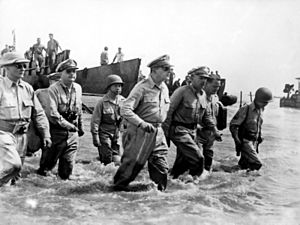
On October 20, 1944, the U.S. Sixth Army landed on Leyte. The U.S. pushed inland, while Japan sent reinforcements. The U.S. air force stopped Japanese attempts to resupply. After fierce fighting, the U.S. gained control of Leyte.
On January 9, 1945, the Sixth Army landed on Luzon, the largest Philippine island. They pushed inland, capturing airfields. American forces closed in on Manila, leading to a month-long battle that caused over 100,000 civilian deaths. The Bataan Peninsula and Corregidor island fortress were also secured.
This was the largest campaign of the Pacific War, involving more U.S. troops than in North Africa or Italy. Of the 250,000 Japanese troops defending Luzon, 80 percent died. Filipino guerrillas helped U.S. forces clear out remaining Japanese resistance.
Final Stages of the War
Burma Campaign (1944–1945)
In late 1944 and early 1945, Allied forces launched offensives to retake Burma. British Commonwealth, Chinese, and American forces fought against Japan.
The Indian XV Corps captured Akyab Island and other islands, setting up airfields. The Chinese and American Northern Combat Area Command advanced in northern Burma, linking up with other Chinese forces. The Ledo Road was completed, but too late to have a big impact.
The Japanese tried to defend behind the Irrawaddy River, but the British Fourteenth Army outflanked them. In March, Allied forces captured Meiktila, disrupting Japanese plans. Mandalay was also captured. The Japanese armies were heavily defeated, and the Burmese population turned against them.
The Fourteenth Army advanced towards Rangoon. An amphibious force captured Rangoon on May 1, finding that the Japanese had already left. The Japanese lost about 150,000 men in Burma, mostly from combat and disease.
Iwo Jima
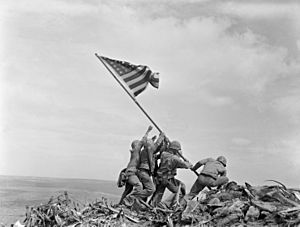
Iwo Jima was a small island halfway between the Marianas and Japan. It was important for early warnings against air raids and for emergency landings for B-29 bombers.
The Japanese commander, Lt. General Tadamichi Kuribayashi, built strong defenses, turning the island into a network of bunkers and tunnels. He knew he couldn't win but hoped to inflict heavy casualties to slow the American advance. About 21,000 Japanese troops defended the island.
The American invasion began on February 19, 1945. The Japanese defenses were very strong, and the Marines faced devastating fire. By the end of the first day, nearly 2,000 Americans were killed or wounded. On February 23, Marines reached the top of Mt. Suribachi, where the famous flag-raising photo was taken. The island was secured on March 26.
Iwo Jima was one of the bloodiest battles for the Americans. American casualties were over 6,800 killed and 19,000 wounded. Almost all the Japanese defenders, over 20,000 men, died.
Okinawa
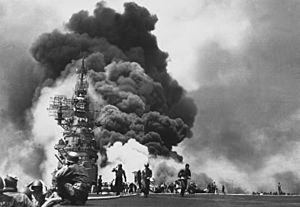
The largest and bloodiest battle for the Americans was at Okinawa. Capturing Okinawa would provide airbases for bombing Japan and a staging area for a possible invasion of the Japanese home islands.
About 75,000–100,000 Japanese troops defended Okinawa. American forces totaled 183,000 troops. The British Pacific Fleet also helped by attacking Japanese airfields.
The main landings on Okinawa happened on April 1, 1945. The Japanese offered little resistance at the beaches, planning to fight inland. The first major Japanese counterattack came on April 6–7, with kamikaze aircraft and a naval operation called Ten-Go. The battleship Yamato and other ships were sent as bait, but they were sunk by American aircraft. Mass kamikaze attacks continued for three months.
The fighting was very tough, especially in the south. The Japanese used the terrain to inflict maximum casualties. Organized resistance ended on June 21. Total American casualties were over 49,000, including 12,520 dead. Japanese casualties were about 110,000 killed. Kamikaze attacks sank 36 ships and killed 4,900 U.S. sailors.
Bombing Japan and Atomic Bombs
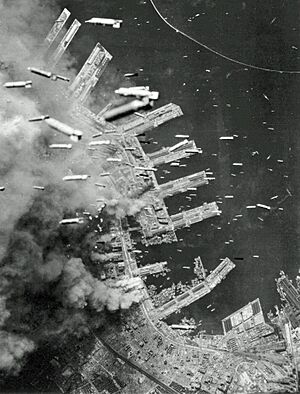
The battles on Iwo Jima and Okinawa showed how costly a direct invasion of Japan would be. This led many American leaders to consider other ways to force Japan to surrender, such as the atomic bombs.
U.S. B-29 bombers carried out intense strategic bombing campaigns against Japanese cities. On March 9–10, 1945, a firebombing raid on Tokyo killed between 80,000 and 100,000 people and destroyed much of the city. Other major cities were also heavily bombed.
On July 26, 1945, U.S. President Harry S. Truman, British Prime Minister Winston Churchill, and Chinese Generalissimo Chiang Kai-shek issued the Potsdam Declaration. This ultimatum told Japan to surrender or face "prompt and utter destruction."
On August 6, 1945, the U.S. dropped an atomic bomb on Hiroshima. On August 9, another atomic bomb was dropped on Nagasaki. Many thousands of people died in these two bombings.
Soviet Union Joins the War
In February 1945, the Soviet Union agreed to join the war against Japan 90 days after Germany surrendered. This was important because the Soviets could tie down many Japanese forces in Manchuria and Korea.
On August 9, 1945, the Soviet Union invaded Manchuria. A large, battle-hardened Soviet force quickly defeated the Japanese Kwantung Army. The Soviet entry into the war was a major factor in Japan's decision to surrender.
Japan Surrenders

The combined effects of the American air and naval attacks, the two atomic bombings, and the Soviet invasion were too much for Japan. On August 10, 1945, Japan decided to accept the Potsdam terms, with one condition about their Emperor.
On August 15, Emperor Hirohito announced Japan's surrender. This day became known as V-J Day (Victory in Japan). The formal surrender document was signed on September 2, 1945, on the USS Missouri. General Douglas MacArthur accepted the surrender and then oversaw the occupation of Japan.
Casualties of the War
Allied Losses
- United States: Over 107,000 American soldiers died in battle, and over 208,000 were wounded. Many also died as prisoners of war. The U.S. and Allied navies lost nearly 200 warships and almost 30,000 aircraft.
- Philippines: About 27,000 Filipino soldiers died, and many more became prisoners. Between 500,000 and 1 million Filipino civilians died due to the war.
- China: Estimates vary, but many sources say China suffered around 20 million to 35 million casualties, including both military and civilians. Millions died from fighting, starvation, and disease. The Japanese "Three Alls Policy" caused immense suffering and deaths among civilians.
- Commonwealth: British, Dominion, and Empire forces suffered about 235,000 casualties, including 82,000 killed. The Royal Navy lost 23 warships. Millions of civilians in India and Burma also died, partly due to famine.
- Other Allies: The Soviet Union had over 68,000 casualties against Japan. The Dutch East Indies Army lost many soldiers, with 8,500 dying as prisoners. Many Indonesian civilians also died from famine. In French Indochina, millions died, mostly due to famine.
Axis Losses
- Japan: Over 2 million Japanese soldiers died during the war, mostly fighting the Americans and Chinese. About 800,000 Japanese civilians also died. The Japanese navy lost over 341 warships, including 11 battleships and 25 aircraft carriers. They also lost over 45,000 aircraft.
- Germany and Italy: These Axis powers had limited losses in the Pacific, mainly a few submarines and raiding ships.
Images for kids
-
Generalissimo Chiang Kai-shek and General Joseph Stilwell, Allied Commander-in-Chief in the China theatre from 1942 to 1945
-
Dutch and Australian PoWs at Tarsau, in Thailand in 1943. 22,000 Australians were captured by the Japanese; 8,000 died as prisoners of war.
-
Hiryū under attack by B-17 Flying Fortress heavy bombers
-
The Allied leaders of the Asian and Pacific Theaters: Generalissimo Chiang Kai-shek, Franklin D. Roosevelt, and Winston Churchill meeting at the Cairo Conference in 1943


